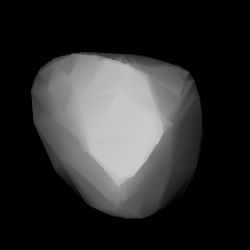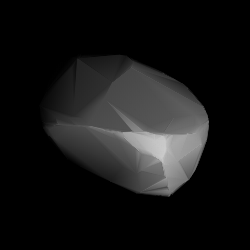Related Research Articles
997 Priska, provisional designation 1923 NR, is a carbonaceous Adeonian asteroid from the central regions of the asteroid belt, approximately 19 kilometers in diameter. It was discovered on 12 July 1923, by astronomer Karl Reinmuth at the Heidelberg-Königstuhl State Observatory in southwest Germany. The asteroid's name is a common German female name, unrelated to the discoverer's contemporaries.
Pawlowia, provisional designation 1923 OX, is a background asteroid from the central regions of the asteroid belt, approximately 20 kilometers in diameter. It was discovered on 5 October 1923, by Soviet astronomer Vladimir Albitsky at the Simeiz Observatory on the Crimean peninsula. The asteroid was named after Russian physiologist and Nobelist Ivan Pavlov.
1024 Hale, provisional designation A923 YO13, is a carbonaceous background asteroid from the outer regions of the asteroid belt, approximately 45 kilometers (28 miles) in diameter. The asteroid was discovered on 2 December 1923, by Belgian–American astronomer George Van Biesbroeck at the Yerkes Observatory in Wisconsin, United States. It was named for American astronomer George Ellery Hale. The dark C-type asteroid may have a rotation period of 16 hours.

1073 Gellivara, provisional designation 1923 OW, is a dark Themistian asteroid, approximately 27 kilometers in diameter, located in the outer regions of the asteroid belt. It was discovered by Austrian astronomer Johann Palisa at the Vienna Observatory on 14 September 1923, and later named after the Swedish town of Gällivare.
6235 Burney, provisional designation 1987 VB, is a Florian or background asteroid from the inner regions of the asteroid belt, approximately 4 kilometers in diameter. It was discovered on 14 November 1987, by Japanese astronomers Seiji Ueda and Hiroshi Kaneda at the Kushiro Observatory on Hokkaido, Japan. The likely elongated L-type asteroid has a rotation period of 15.5 hours. It was named for Venetia Burney, who first proposed Pluto's name.

1165 Imprinetta, provisional designation 1930 HM, is a carbonaceous Meliboean asteroid from the outer regions of the asteroid belt, approximately 49 kilometers (30 mi) in diameter. It was discovered on 24 April 1930 by Dutch astronomer Hendrik van Gent at the Union Observatory in Johannesburg, South Africa. The asteroid was named after Imprinetta Gent, wife of the discoverer.
11277 Ballard (provisional designation 1988 TW2) is a Phocaea asteroid from the inner regions of the asteroid belt, approximately 6.3 kilometers (3.9 miles) in diameter. It was discovered on 8 October 1988, by American astronomer couple Carolyn and Eugene Shoemaker at the Palomar Observatory in California. The assumed S-type asteroid has a rotation period of at least 10 hours. It was named for American marine scientist Robert Ballard.

14627 Emilkowalski is a stony asteroid from the central region of the asteroid belt, approximately 7 kilometers in diameter. It was discovered on 7 November 1998, by American astronomer Richard Kowalski at the Quail Hollow Observatory in Zephyrhills, Florida, United States. The asteroid is the namesake of the recently formed Emilkowalski family of asteroids. It was named after Emil Kowalski, mentor of the discoverer.
9298 Geake, provisional designation 1985 JM, is a Mitidika asteroid from the central regions of the asteroid belt, approximately 12 kilometers in diameter. It was discovered on 15 May 1985, by American astronomer Edward Bowell at Lowell Observatory's Anderson Mesa Station near Flagstaff, Arizona, United States. The asteroid was named for British astronomer John E. Geake.
1452 Hunnia, provisional designation 1938 DZ1, is a carbonaceous Meliboean asteroid from the outer regions of the asteroid belt, approximately 20 kilometers in diameter. It was discovered on 26 February 1938, by Hungarian astronomer György Kulin at the Konkoly Observatory in Budapest. The asteroid was named in honor of the Hungarian nation.
2324 Janice, provisional designation 1978 VS4, is a dark background asteroid from the outer regions of the asteroid belt, approximately 25 kilometers (16 miles) in diameter. It was discovered on 7 November 1978, by American astronomers Eleanor Helin and Schelte Bus at the Palomar Observatory in California. The asteroid was named for Janice Cline at Caltech. The presumably C-type asteroid has a rotation period of 23.2 hours.

1836 Komarov is a carbonaceous Dorian asteroid from the central region of the asteroid belt, approximately 22 kilometers in diameter. It was discovered on 26 July 1971 by Russian astronomer Nikolai Chernykh at Crimean Astrophysical Observatory in Nauchnij on the Crimean peninsula. It was named after Soviet cosmonaut Vladimir Komarov.
4944 Kozlovskij, provisional designation 1987 RP3, is a carbonaceous Witt asteroid from the central regions of the asteroid belt, approximately 10 kilometers (6 miles) in diameter. It was discovered on 2 September 1987, by Soviet astronomer Lyudmila Chernykh at the Crimean Astrophysical Observatory in Nauchnij, on the Crimean Peninsula. The asteroid was named for Russian opera singer Ivan Kozlovsky.
1303 Luthera, provisional designation 1928 FP, is a dark asteroid and the parent body of the Luthera family, located in the outermost regions of the asteroid belt. It measures approximately 90 kilometers in diameter. The asteroid was discovered on 16 March 1928, by astronomer Friedrich Schwassmann at the Bergedorf Observatory in Hamburg, Germany, and later named after German astronomer Robert Luther.
1696 Nurmela, provisional designation 1939 FF, is a Baptistina asteroid from the inner regions of the asteroid belt, approximately 10 kilometers in diameter. It was discovered on 18 March 1939, by Finnish astronomer Yrjö Väisälä at Turku Observatory in Southwest Finland, and named after Finnish academician Tauno Nurmela. The possibly elongated asteroid has a rotation period of 3.15 hours.
1416 Renauxa, provisional designation 1937 EC, is an Eon asteroid from the outer regions of the asteroid belt, approximately 29 kilometers in diameter. It was discovered on 4 March 1937, by French astronomer Louis Boyer at the Algiers Observatory in Algeria, North Africa. It was named after Joseph Renaux, an astronomer at the discovering observatory.
1306 Scythia, provisional designation 1930 OB, is a dark Ursula asteroid from the outer regions of the asteroid belt, approximately 72 kilometers in diameter. It was discovered on 22 July 1930, by Soviet astronomer Grigory Neujmin at the Simeiz Observatory on the Crimean peninsula. The asteroid was named for the historic region of Scythia.
4176 Sudek, provisional designation 1987 DS, is a Themistian asteroid from the outer regions of the asteroid belt, approximately 17 kilometers in diameter. It was discovered on 24 February 1987, by Czech astronomer Antonín Mrkos at the Kleť Observatory in the Czech Republic. The presumed C-type asteroid has a rotation period of 8.16 hours. It was named in memory of Czech photographer Josef Sudek.
2169 Taiwan, provisional designation 1964 VP1, is a carbonaceous Astridian asteroid from the central regions of the asteroid belt, approximately 17 kilometers in diameter. It was discovered on 9 November 1964, by astronomers at the Purple Mountain Observatory near Nanking, China. It was named for Taiwan.
6229 Tursachan, provisional designation 1983 VN7, is a Themistian asteroid from the outer regions of the asteroid belt, approximately 10 kilometers (6 miles) in diameter. It was discovered on 4 November 1983, by American astronomer Brian Skiff at Lowell's Anderson Mesa Station near Flagstaff, Arizona, in the United States. The presumed C-type asteroid has a rotation period of 16.6 hours and is possibly elongated. It was named after a Gaelic word meaning "Standing Stones".
References
- 1 2 3 4 "JPL Small-Body Database Browser: 4962 Vecherka (1973 TP)" (2017-05-23 last obs.). Jet Propulsion Laboratory . Retrieved 21 September 2017.
- 1 2 3 Schmadel, Lutz D. (2007). "(4962) Vecherka". Dictionary of Minor Planet Names. Springer Berlin Heidelberg. p. 427. doi:10.1007/978-3-540-29925-7_4840. ISBN 978-3-540-00238-3.
- 1 2 "Asteroid 4962 Vecherka – Proper Elements". AstDyS-2, Asteroids – Dynamic Site. Retrieved 29 October 2019.
- 1 2 "Small Bodies Data Ferret". Nesvorny HCM Asteroid Families V3.0. Archived from the original on 2 August 2017. Retrieved 21 September 2017.
- 1 2 3 4 Masiero, Joseph R.; Mainzer, A. K.; Grav, T.; Bauer, J. M.; Cutri, R. M.; Nugent, C.; et al. (November 2012). "Preliminary Analysis of WISE/NEOWISE 3-Band Cryogenic and Post-cryogenic Observations of Main Belt Asteroids". The Astrophysical Journal Letters. 759 (1): 5. arXiv: 1209.5794 . Bibcode:2012ApJ...759L...8M. doi:10.1088/2041-8205/759/1/L8.
- 1 2 3 4 Nugent, C. R.; Mainzer, A.; Bauer, J.; Cutri, R. M.; Kramer, E. A.; Grav, T.; et al. (September 2016). "NEOWISE Reactivation Mission Year Two: Asteroid Diameters and Albedos". The Astronomical Journal. 152 (3): 12. arXiv: 1606.08923 . Bibcode:2016AJ....152...63N. doi: 10.3847/0004-6256/152/3/63 .
- 1 2 3 Masiero, Joseph R.; Mainzer, A. K.; Grav, T.; Bauer, J. M.; Cutri, R. M.; Dailey, J.; et al. (November 2011). "Main Belt Asteroids with WISE/NEOWISE. I. Preliminary Albedos and Diameters". The Astrophysical Journal. 741 (2): 20. arXiv: 1109.4096 . Bibcode:2011ApJ...741...68M. doi:10.1088/0004-637X/741/2/68.
- 1 2 3 4 Mainzer, A.; Grav, T.; Masiero, J.; Hand, E.; Bauer, J.; Tholen, D.; et al. (November 2011). "NEOWISE Studies of Spectrophotometrically Classified Asteroids: Preliminary Results". The Astrophysical Journal. 741 (2): 25. arXiv: 1109.6407 . Bibcode:2011ApJ...741...90M. doi:10.1088/0004-637X/741/2/90.
- 1 2 3 4 5 6 "LCDB Data for (4962) Vecherka". Asteroid Lightcurve Database (LCDB). Retrieved 21 September 2017.
- 1 2 Tomov, Dimitar; Kurtenkov, Alexander; Enimanev, Mihail; Teneva, Deana (October 2016). "Asteroid 4962 Vecherka: A High-Amplitude Slow Rotator". The Minor Planet Bulletin. 43 (4): 321–322. Bibcode:2016MPBu...43..321T. ISSN 1052-8091.
- ↑ Veres, Peter; Jedicke, Robert; Fitzsimmons, Alan; Denneau, Larry; Granvik, Mikael; Bolin, Bryce; et al. (November 2015). "Absolute magnitudes and slope parameters for 250,000 asteroids observed by Pan-STARRS PS1 – Preliminary results". Icarus. 261: 34–47. arXiv: 1506.00762 . Bibcode:2015Icar..261...34V. doi:10.1016/j.icarus.2015.08.007.
- 1 2 "4962 Vecherka (1973 TP)". Minor Planet Center. Retrieved 21 September 2017.
- ↑ Nesvorný, D.; Broz, M.; Carruba, V. (December 2014). "Identification and Dynamical Properties of Asteroid Families". Asteroids IV. pp. 297–321. arXiv: 1502.01628 . Bibcode:2015aste.book..297N. doi:10.2458/azu_uapress_9780816532131-ch016. ISBN 978-0-8165-3213-1.
- ↑ "MPC/MPO/MPS Archive". Minor Planet Center. Retrieved 21 September 2017.